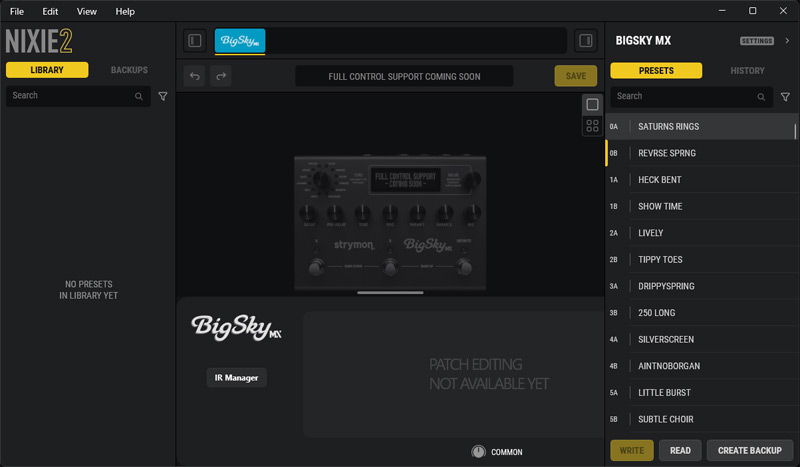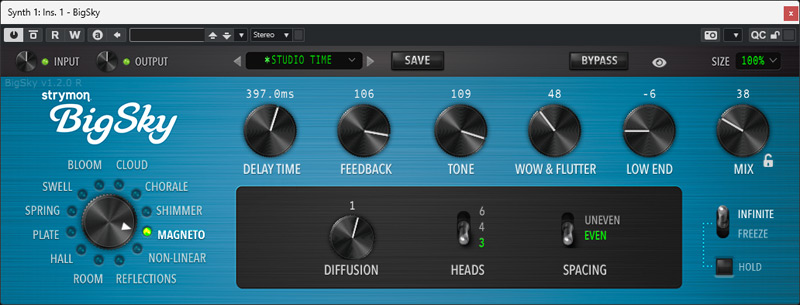Strymon BigSky MX
Extended version of the classic reverb pedal
Author and photos: Peter Kaminski
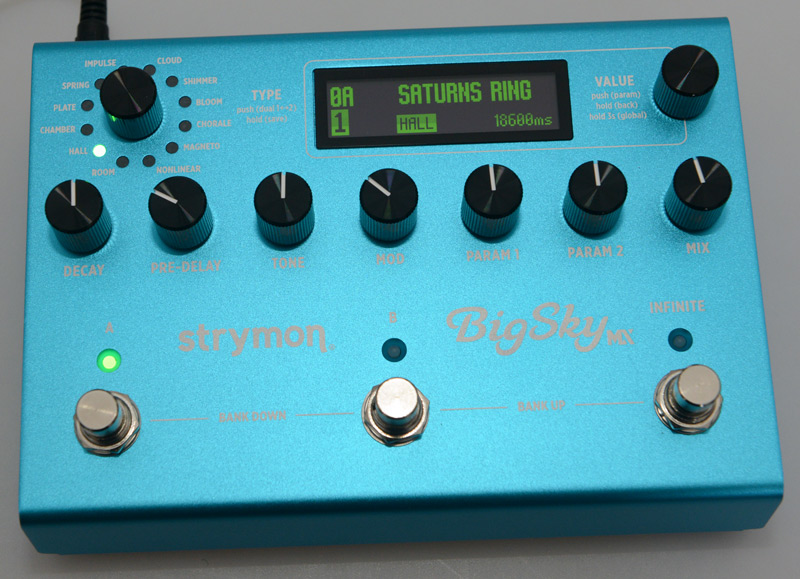
Strymon’s BigSky was introduced back in 2013 and has since become an effects pedal classic, especially for ambient guitar sounds. In early 2023, Strymon released the BigSky Cloudburst ambient reverb pedal, which also caused a sensation in terms of sound. At the beginning of 2024, Strymon introduced its reverb flagship, the BigSky MX pedal. Much was taken over from the BigSky, but a lot is also new and the BigSky MX is not a direct successor, as the BigSky is still available. Strymon itself describes the BigSky MX as a reverb workstation which can do a whole lot more than the BigSky, but it is also positioned in a different price range.
Concept and connections
Although BigSky still had a 366 MHz SHARC DSP, the BigSky MX uses an 800 MHz ARM processor with three cores. This allows not only new algorithms but also two independent Hall engines to be connected in series or in parallel.

Like the BigSky Stereo, the BigSky MX has inputs and outputs. In terms of A/D and D/A conversion, not much has changed in terms of technical data. Here, 24-bit converters with a sampling rate of 96 kHz are used. The input impedance is one megaohm, and the input stage is now equipped with discrete J-FET transistors. The output impedance is 100 ohms. The Left In/Out can also be operated as a mono input and output. With a high input impedance, an electric guitar can also be connected directly. The maximum input level is +10dBu. The signal-to-noise ratio is specified by the manufacturer as 116dB typ. This is compared with 115dB typ. of BigSky.
Like the BigSky, the BigSky MX offers MIDI input and output via 5-pin DIN sockets as well as a jack socket for connecting an expression pedal. A new feature is the USB-C port for updates and software editing. BigSky MX requires a 9 Volt power supply with at least 500mA output current, such as those provided by Strymon Zuma or Ojai. The new ARM processor is not only more powerful but also more power-hungry. The size of the Strymon BigSky MX is 172 x 127 x 48 mm.
Operation
Although the housing size of the BigSky MX is very similar to that of the BigSky (a standard size like the IK Multimedia Tonex, for example), the arrangement of the controls is new. The parameter encoders are now arranged in a row. The selection encoder for the algorithms, which is also used to save the preset via the print function, and the push/rotary encoder for the menu and parameter selection are located on the left and right sides of the display. The OLED display now has a much higher resolution and offers a much better overview than the BigSky.

The functionality of the three foot-buttons has also changed. The first two on the left and in the middle are for the direct selection of one of two presets in a "bank" and the first on the far right is now for triggering the INFINITE function. This can be selected via the menu to a momentary function (Momentary) or an on/off switching function (Latching). By pressing the left/center or center/right buttons, the user can change the currently active bank (back or forward).

The normal display (see illustration above) shows the bank number and position (A/B), as well as the name of the preset. The first 50 banks are equipped with factory presets, and there are a 100 more banks for user-created presets. The display also shows which reverb engines are active, how they are connected, and the decay parameter value.

Briefly pressing the rotary encoder to the right of the display takes you to the menu with the individual preset parameters (see illustration above).

A longer press opens the global parameter menu where, for example, the MIDI parameters can be set. Here, you can also activate the impulse response-based CAB FILTER if required, which simulates different loudspeaker cabinets, of which three can be selected: Bright, Dark, and Classic. The latter is an IR that simulates a typical guitar amp with EQ settings and microphone pickup. Incidentally, there was a switch on the back of the BigSky for activation. I find the BigSky MX’s global parameter solution more practical and up-to-date.
Algorithms
Although the number of algorithms has remained the same, the types of algorithms offered have changed. Many of the algorithms have also been revised, as more computing power is available due to the new processor and algorithms could be optimised here. Incidentally, the ARM processor also enables 32-bit floating point calculations. In addition to the new algorithms of the BigSky MX, the algorithm version of the BigSky (Classic) is also available. This can be set in the preset parameter menu via the "Voice" parameter (setting value MX/Classic). Both internal reverb engines have a panorama control to adjust the level of the respective reverb engine on the left and right channels.

Let’s go through the algorithms in detail. The IMPUSE algorithm is a brand-new algorithm that offers a convolution reverb with 22 selectable internal impulse responses of up to ten seconds in length. It is also possible to load your own impulse responses. I will discuss this more later.
SPRING (reverb spiral) and PLATE (reverb plate) were already available on the BigSky and, as previously mentioned, the previous and the new MX algorithm are available here.
The next three algorithms are room simulations and called CHAMBER, HALL, and ROOM. CHAMBER is a new algorithm that simulates rooms with medium reverb density and a clear direct sound. Some parameter options offer the possibility of adjusting the sound as you would have it when recording in a room, depending on the microphones, preamps, and speakers used. HALL and ROOM were already available on the BigSky. HALL is for larger rooms (CONCERT or ARENA modes), and ROOM reproduces smaller rooms from the studio to the size of a nightclub.
Now to the other algorithms that are also more effect-oriented: NONLINEAR is used for reverbs with a non-linear progression such as gated reverb, tremelo (called CHOP, which was not available on the BigSky) or reverse reverb. There are six different reverb sequences available here. However, there is no switch to CLASSIC mode here, although this algorithm was already available in the BigSky.
MAGNETO, CHORALE, BLOOM, SHIMMER, and CLOUD are well-known reverb effect types, all of which already existed in the BigSky but have all been significantly revised. MAGNETO is a classic tape-loop delay with up to six virtual playback heads. What’s new here compared to BigSky is the ping-pong effect. CHORALE features a new choir engine with which a voice can be synthesized and added. BLOOM is based on the Bloom algorithm, as found in reverb units from the 90s (classically in the Alesis Midiverb II). SHIMMER offers two voices that can be shifted in frequency. A new feature of the CLOUD algorithm is the Ensemble Engine, which adds harmonics that are reminiscent of string instruments.
Updates
To update the firmware for its pedals, Strymon offers the "Strymon Update" software, which is available for macOS from version 11.6 and for Windows from version 10.
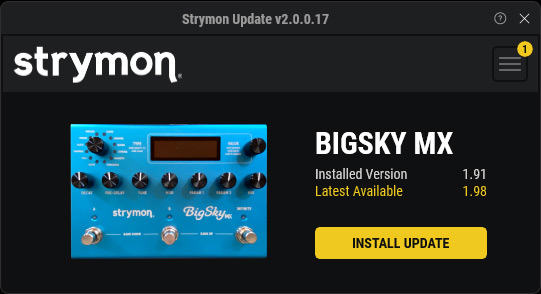
To update, simply connect the BigSky MX to the computer and start the software. It will then automatically find Strymon pedals connected via USB and, if necessary, offer a firmware update directly (see illustration above). After clicking on INSTALL UPDATE, the firmware will be uploaded and after the update, the software will inform you that the installed version corresponds to the latest available version.
Software
There is also a second software from Stryman for its pedals, namely NIXIE2 for handling and editing presets and for performing backups, etc.
At the time of our test, the functionality was not fully implemented; thus, presets could not be edited at the time of writing this test.
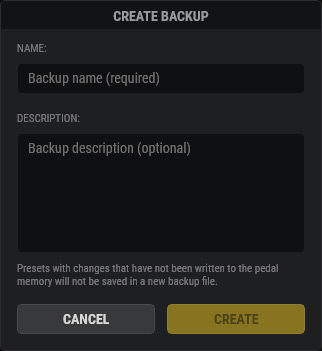
What is possible, however, are important backups, for example.
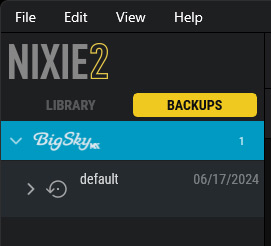
Practise
The Big Sky MX is certainly primarily intended for use with electric guitars, but it is also suitable for synthesizers and Eurorack module systems, especially for live use. I am definitely impressed by the algorithms in connection with synthesizers. The presets are optimised for use with an electric guitar, and the parameters may need to be adjusted if necessary; in particular, the decay time should usually be set to a smaller value here. You should also try out the Strymon BigSky MX for vocals. Very appealing effects are also possible here.

Strymon also offers effect Eurorack modules, and the AA.1, a module with which effect pedals can be integrated into a Eurorack system. Level (+/-18dB) and connections (3.5/6.3mm jack) are converted accordingly. A very practical tool, which we also use in our studio patch case and which also works perfectly with the Big Sky MX (see photo below). In addition to the 6.3-mm patch cable, an adapter from stereo jack to two mono jack plugs is required for operation because the input to the AA.1 module is designed as a stereo jack.

A shimmer algorithm can also be found in a similar form in other devices and plug-ins; however, this algorithm is also more flexible than in other implementations. Some algorithms, such as CHORALE and CLOUD, really have unique sound characteristics, especially the new variants of the BigSky MX. It’s nice to be able to use the BigSky algorithm variants as well. However, I personally prefer the BigSky MX, which somehow sounds even more sophisticated and interesting.
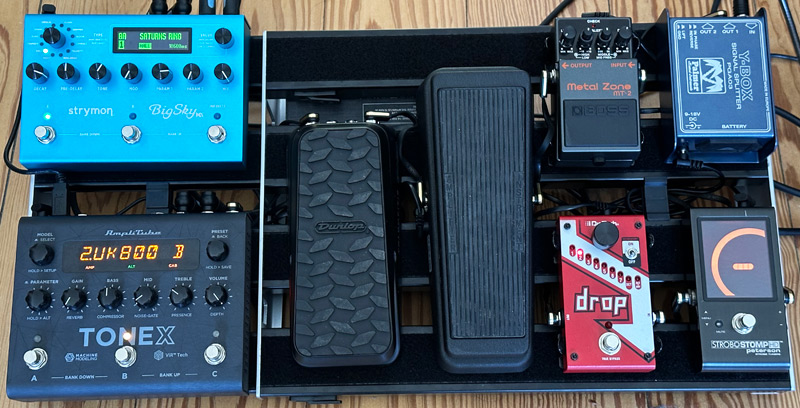
According to my opinion, the operation was improved by the new arrangement of the rotary encoders. In general, the operation is almost completely intuitive after a short time. In most cases, a position to the right of the 12 o’clock position is required for the mix control because the effect path is usually too quiet in the middle position.
The CAB FILTER should be considered as an option for those who don’t have any other amp/cabinet simulation pedals. I still like the CLASSIC setting best here. The function is global; therefore, it can be turned on or off for all presets. I prefer the TONEXT pedal from IK Multimedia for the purpose of cabinet simulation because it is, of course, much more flexible in terms of sound design. In most cases, I deactivate the reverb in the TONEX because the BigSky is, of course, the first choice and superior to the TONEX.
Some forums and reports have criticised the fact that you can only select two presets on the BigSky MX without changing banks. Personally, however, I prefer the fact that there is now a separate Invitiy/Freeze button, as this makes perfect sense, especially for ambient guitar sounds. I also saw a YouTube video where people have criticised the fact that distortion occurs at some point as the freeze time increases. Ultimately, this is also the case with loop tape recorders because at some point, you naturally reach saturation if more and more audio signals are added to a loop. In this case, you simply have to reduce the level and, if necessary, end the freeze state using the new footswitch. So I don’t see either point as critical at all. This could be achieved via normalisation, and if Strymon provides this feature this in an update, I hope that the operation without normalisation will also be made possible via a parameter. Let’s see what else the updates bring. The device was still relatively new on the market at the time of testing.
To summarise, it can be said that the "reverb workstation", as Strymon calls its BigSky MX, is not just a marketing slogan. The tonal range of the BigSky MX is unparalleled anywhere else on the market, even among professional studio devices and plug-ins, in terms of tonal quality and flexibility.
Conclusion
It should also be noted that unlike the BigSky MX, the BigSky is also available as a plug-in from Strymon. This means that you at least have access to the BigSky algorithms in DAW. The price of this plug-in is around 230 euros.
The list price of the Strymon Big Sky MX is less than 800 euros. For a reverb pedal, that’s quite a house number. As already mentioned, the Big Sky is still available at a price of around 240 euros less than the Big Sky MX. So it’s definitely interesting for the price-conscious.
But the price of the BigSky MX is quickly put into perspective when you take a closer look at the services it offers. Personally, I therefore recommend going straight for the BigSky MX - if the budget allows - because it offers a whole range of new features compared to the BigSky "without MX", such as two reverb engines, revised and new algorithms, loadable impulse responses, firmware updating via USB, and preset editing soon via the NIXIE2 software, OLED display, and the Invinity footswitch, which definitely justify the extra price.
In terms of sound, I would describe a summary as follows: In my opinion, the BigSky MX is currently the best reverb unit available for instruments or as a floor effects unit. Although it is physically designed as a pedal, its range of applications is much wider: it is an effects unit and room simulation in one product at a very high level. In our test studio, the BigSky MX will be used as a permanent reference even after the test because, in my opinion, there is no alternative, and this is especially true for using an electric guitar with it.
 How to resolve AdBlock issue?
How to resolve AdBlock issue? 